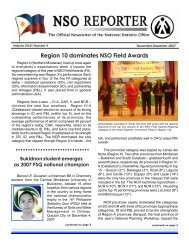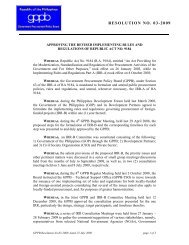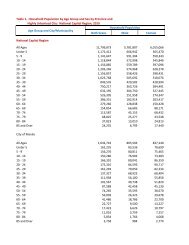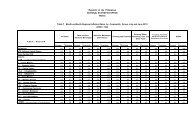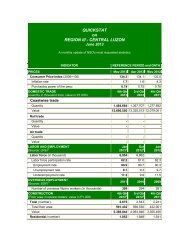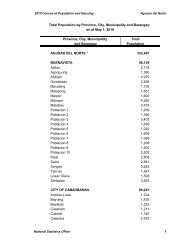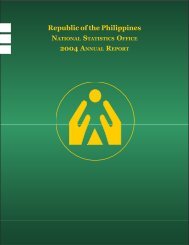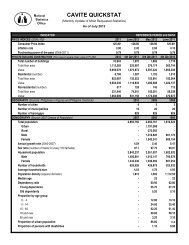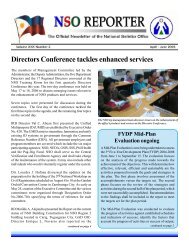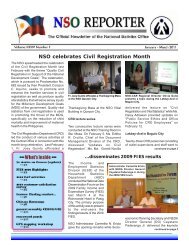NATIONAL STATISTICS OFFICE 2001 ANNUAL REPORT
NATIONAL STATISTICS OFFICE 2001 ANNUAL REPORT
NATIONAL STATISTICS OFFICE 2001 ANNUAL REPORT
You also want an ePaper? Increase the reach of your titles
YUMPU automatically turns print PDFs into web optimized ePapers that Google loves.
Department<br />
Accomplishments<br />
Avenue was open from 7:00 am to 5:00 pm. At the<br />
releasing area at EDSA, NSO adopted a policy of<br />
“servicing the clients until the last person is served”.<br />
The NSO Archive<br />
As the central repository of all civil registry<br />
documents, the NSO to date has a total of<br />
approximately 120 million documents and is<br />
increasing, on the average, by 3 million documents<br />
annually.<br />
For <strong>2001</strong>, a total of 6,695,798 documents<br />
representing vital events were submitted through the<br />
provincial statistics offices by the local civil registry<br />
offices have been added to the archive. There were<br />
1.859 million documents microfilmed and 10.338<br />
million documents were scanned, indexed and<br />
loaded into the computerized database.<br />
The NSO’s commitment in the preservation<br />
and safekeeping of documents paved the way for<br />
reconstructing vital records for the benefit of<br />
different civil registry offices nationwide. However,<br />
for <strong>2001</strong>, the NSO temporarily suspended accepting<br />
requests for reconstruction of vital records.<br />
Solutions<br />
Despite its extremely limited resources, the<br />
NSO took on the challenge of providing better public<br />
service. The following were the management’s<br />
responses to the situation:<br />
Civil Registry System-Information<br />
Technology Project (CRS-ITP)<br />
This is the civil registry computerization<br />
project, in cooperation with Unisys Philippines, Inc.,<br />
launched in April 2000 under a Build-Operate-<br />
Transfer (BOT) scheme, primarily aimed at providing<br />
a more efficient storage and retrieval system and a<br />
“while-you-wait” service in various service points (or<br />
outlets) nationwide. The broad scope of work of<br />
Unisys includes the supply of IT equipment,<br />
development of application systems, scanning and<br />
indexing of the documents, database maintenance,<br />
site preparation, system integration as well as the<br />
information campaign, while NSO provides the<br />
frontline personnel during the actual operations.<br />
Project cooperation period between NSO and<br />
Unisys will last for 12 years. The first seven years are<br />
devoted to development and the last five years will be<br />
purely for operations. The development stage is<br />
divided into four phases with specific deliverables in<br />
each phase. Phase 1 covers the development of the<br />
various application systems, the setting up of the<br />
Central Facility and five Metro Manila outlets, and the<br />
conversion of the first batch of documents (around 55<br />
M). Phase 2, which is targeted for year 2002, will set<br />
up more service outlets to be located in the regional<br />
centers plus the continuing conversion of the second<br />
batch of documents. The third phase, scheduled for<br />
year 2003, will bring the service much closer to the<br />
citizenry by setting up outlets in the NSO provincial<br />
offices and continuing conversion of documents.<br />
Finally, the fourth phase will be devoted to conversion<br />
of the remaining documents and assessment of the<br />
system for possible upgrade.<br />
For <strong>2001</strong>, the first phase was completed with<br />
the following major accomplishments:<br />
a. Application Systems Development. All the major<br />
systems required for the outlets operations have<br />
been developed, tested, and implemented.<br />
b. Conversion of Documents. The scanning and<br />
indexing of the birth documents for loading into<br />
the database ran full-blast. The scanned<br />
documents reached the 52 million mark but the<br />
creation of index and its quality assurance<br />
experienced lower production rates than<br />
expected. The quality of the documents had been<br />
the primary deterrent to the acceleration of the<br />
indexing process. At the end of <strong>2001</strong> there were<br />
about 14 million of the 120 million documents<br />
loaded in production or in the computerized<br />
<strong>2001</strong> NSO Annual Report 19



